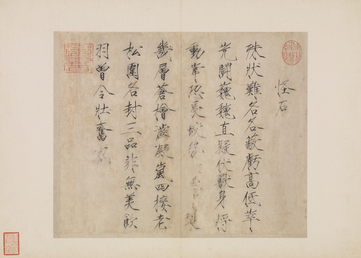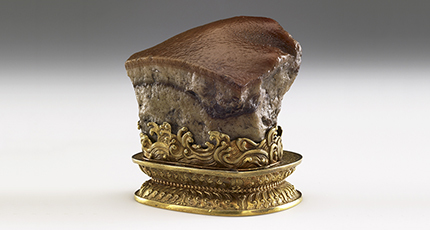The Inscrutable East (Los Altos Town Crier, September 2016)
 The current marquee exhibit at the Asian Art Museum in San Francisco – open to view through September 18 – is of Chinese art on loan from the National Palace Museum, Taipei. The exhibit includes wonderful paintings of misty Chinese landscapes and scrolls-ful of imperial gatherings and parades. It includes beautiful ceramics, enamel-work and lacquerware, some examples pristinely simple and others decadently ornate, something for every taste.
The current marquee exhibit at the Asian Art Museum in San Francisco – open to view through September 18 – is of Chinese art on loan from the National Palace Museum, Taipei. The exhibit includes wonderful paintings of misty Chinese landscapes and scrolls-ful of imperial gatherings and parades. It includes beautiful ceramics, enamel-work and lacquerware, some examples pristinely simple and others decadently ornate, something for every taste.
 And then there is the calligraphy. This is a class of artwork which is so foreign to Western eyes as to almost not be recognizable as art. In China, a fine hand at calligraphy is seen as reflecting a worthy soul. There are standard forms which have originated with revered scholars or national heroes and have been passed down as models for centuries. Emperors proved their right to celestial status by elegantly inscribing poems in tribute to a masterpiece of painting on the painting itself, adding to, not subtracting from their artistic value. Imagine if Louis XIV had written a sonnet in the upper left corner of the “Mona Lisa”!
And then there is the calligraphy. This is a class of artwork which is so foreign to Western eyes as to almost not be recognizable as art. In China, a fine hand at calligraphy is seen as reflecting a worthy soul. There are standard forms which have originated with revered scholars or national heroes and have been passed down as models for centuries. Emperors proved their right to celestial status by elegantly inscribing poems in tribute to a masterpiece of painting on the painting itself, adding to, not subtracting from their artistic value. Imagine if Louis XIV had written a sonnet in the upper left corner of the “Mona Lisa”!
The contrast with Western ideas is painful. In many of our elementary schools “Handwriting” has recently been discontinued as a skill on which to be graded, replaced by “Keyboarding” as being more in line with contemporary needs. Neither of my sons has ever mastered cursive writing. How can we judge a series of artworks which consist entirely of handwriting samples? Especially when the samples are of Chinese ideographs which convey no meaning to most Westerners?
 This exhibit of the Emperor’s treasures also highlights another Chinese art form which is opaque to my Western eyes: stone food. When I was a child and didn’t want to eat my dinner, my mother would remind me of the starving children in China. Perhaps the cyclical famines which are part of China’s history through the second half of the 20th century have sparked the Chinese obsession with food, which extends down to the simplest daily greeting. (The Chinese equivalent of our “How do you do?” is “Ni chi le ma?” which translates to “Have you eaten?”)
This exhibit of the Emperor’s treasures also highlights another Chinese art form which is opaque to my Western eyes: stone food. When I was a child and didn’t want to eat my dinner, my mother would remind me of the starving children in China. Perhaps the cyclical famines which are part of China’s history through the second half of the 20th century have sparked the Chinese obsession with food, which extends down to the simplest daily greeting. (The Chinese equivalent of our “How do you do?” is “Ni chi le ma?” which translates to “Have you eaten?”)
The most famous item among the borrowed treasures of the exhibit, saved for last and shown dramatically behind a barrier so it won’t be accidentally glimpsed in a way that would lessen its impact, is billed as “the US debut of ‘Meat-shaped Stone’, a world-famous sculpture resembling a piece of braised pork belly.” Are you kidding me? Why would anyone want to make a sculpture of a piece of fatty meat? And that is what it is – a large piece of jasper, its top surface stained with ochre dyes and engraved with small dots to resemble pores in the hide, its striations bearing an uncanny resemblance to a thick cut of bacon.
Just to make sure you get the point, the Museum Café, together with other Chinese restaurants in San Francisco, is offering an opportunity to eat genuine braised pork belly (dongpo rou) so that you can see for yourself how truly the hunk of striated and stained jasper on its golden stand does resemble a cut of meat. It is amazing to see (and delicious to taste) how truly the artist has emulated the meat – but why? Perhaps this treasure was viewed by the emperor as a sort of eternal defense against starvation. Perhaps, unlike King Midas in our folklore, the Emperor could gain nourishment from food made of stone and metal. 
Maybe the category of “still life” painting in European art is a reasonable parallel, although these realistic portrayals of fruit, wine, and dead game almost always show the meal unpeeled and unbutchered. Perhaps we Westerners are just a little more squeamish. There’s still time for you to trek up to San Francisco and decide for yourself whether “Meat-shaped Stone” is art. At the least, you can have an exotic lunch!